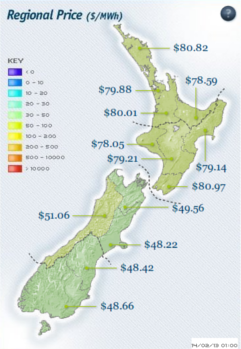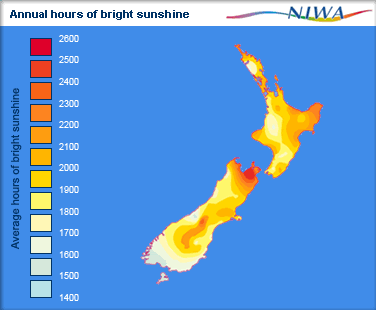When flying to New Zealand’s capital Wellington, two major aspects regarding domestic renewables in this country become immediately apparent. First of all, New Zealand possess a huge potential of wind power. This will become evident during the plane’s approach when it gets hit by major cross winds. Besides the shaky approach, you will notice that Wellington’s roofs have almost no solar panel installations. That is astonishing, since cities in the neighbouring country Australia experience less annual sunshine hours (Melbourne in the state of Victoria experiences 1955 hours of sunshine [1], whereas Wellington experiences 2110 hours [2]), but the solar industry is simply booming in Australia.
- solar map of New Zealand (Source: EECA)
But the non-existing solar panels are not a sign for New Zealand’s lack of renewables. At the moment, New Zealand is generating 75% of its electricity from clean sources (particular hydro and large scale wind power) [3], which puts them third behind Iceland and Norway when it comes to the highest renewable energy contribution. The Kiwi’s plan to extend their renewable share and they want increase it to 90% by 2025 [4].
For a long time, New Zealand policies were driven by an astonishing rational approach of free market, explains Alick Shaw, former deputy Mayor of Wellington. For renewable energies that meant that no tax incentives, feed-in-tariffs or forced power purchase agreements are present in the market. But, and that is a major difference compared to other countries,

regional price of electricity in New Zealand (Source: em6live)
the same applies to other energy sources as well. If energy utilities want to purchase clean energy to fulfill the renewable energy and carbon obligations, they purchase the clean energy on the wholesale market with prices changing by the second. If renewables would be competitive, they would be ruled-out of the market. But New Zealand proves that renewables are competitive at a market level.
But what is the situation for domestic renewable installations? Also here, the general political opinion applies and the government is not providing financial incentives to boost domestic renewables [5]. Hamish Trolove, Senior Engineer at the governmental Energy Efficiency and Conservation Agency explains, that policy makers are concerned that additional governmental support for small scale renewables e.g. in form of a feed in tariff would not replace coal or gas power plants, but older renewable energy installations. Getting closer to 90% of renewable energy share of electricity production, these measures would not increase the share of renewables. Therefore the focus for domestic energy policies by policy makers is around energy conservation, in particular home insulation [6]. At the moment, owners of homes, which have been built before 2000 can apply for insulation grants, which provide 30% of the installation costs, up to 1,500 NZ dollars [7]. Additional funding and grants are available for holders of Community Services Cards. Energy conservation for New Zealanders with low income are of strong interest to the policy makers in Wellington. Michael Begg from the Christchurch Agency for Energy points out that the energy conservation efforts go beyond purely saving energy. He explains that New Zealand, like many other nations, experience ‘Energy Poverty’, where people simply cannot afford to heat their homes. Better insulated homes will help to go further with the same amount of monthly spend. The government experiences another interesting effect through the grants. Residents of damp and poorly insulated house are heavily affected by the health issues related to cold and drafty living environment. At the end it is cheaper for the general public to provide NZD 1,500 grants than paying much larger bills in public healthcare spending. Summarising Hamish Trolove points out that the grant program seems to be a success since more than 280.000 New Zealander households have already applied for the funding support, .
In this very advanced renewable energy society, where does re.nooble see the future of domestic renewable installation?
We strongly think that, despite the lack of incentives, domestic generation is financially viable and can be a good investment for New Zealanders. They are not only a perfect energy source for remote off-grid properties (and New Zealand has plenty of them), but considering that New Zealand experiences a price hike in electricity prices [8], domestic renewable installations will provide a reliable and cost-stable investment for New Zealanders.
References:
[1]: http://www.bom.gov.au/climate/averages/tables/cw_086071.shtml
[2]: http://www.niwa.co.nz/education-and-training/schools/resources/climate/sunshine
[3]: http://www.eeca.govt.nz/efficient-and-renewable-energy/renewable-energy
[4]: http://www.med.govt.nz/sectors-industries/energy/pdf-docs-library/energy-strategies/nzes.pdf
[5]: http://www.seanz.org.nz/Resources/Government-Incentives
[6]: http://www.energywise.govt.nz/
[7]: http://www.energywise.govt.nz/funding-and-programmes/insulation-and-clean-heating
[8]: http://nzh.tw/10863083 or http://www.nzherald.co.nz/business/news/article.cfm?c_id=3&objectid=10863083

